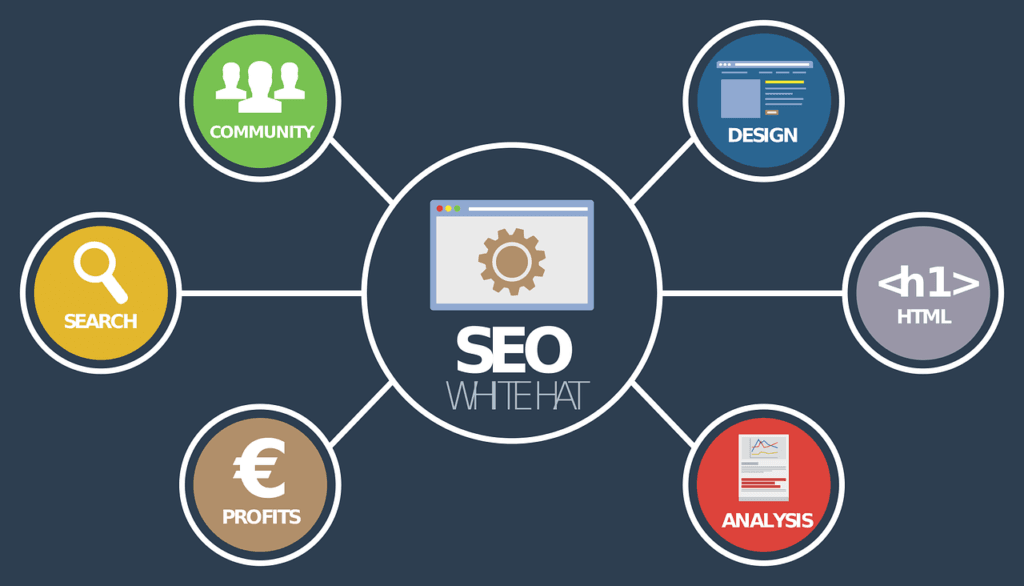(This Article has been revised, edited and added to, by Poulomi Chakraborty.)
The world of healthcare is inherently personal. Every individual, at some point in their life, seeks medical guidance or care. In our digital age, the initial step for many begins with an online search, making the website of a healthcare provider an essential touchpoint. It’s not just about having a website, but having a well-optimized one. Dive deep with us into the structure and elements of a top-tier healthcare website, ensuring it not only draws visitors but also provides valuable, actionable insights.
The Backbone: User-Centered Design
In the heart of an optimized healthcare website lies its design. But this isn’t about aesthetic beauty. It’s about understanding the user.
- Responsive Design: Given the variety of devices available, a well-optimized site should adapt seamlessly, be it on a desktop, tablet, or smartphone. This ensures every user has a consistent and positive experience.
- Easy Navigation: The last thing a visitor seeking medical help wants is to get lost in a labyrinth of links. Clear menus, intuitive layouts, and a prominent search bar can guide users effectively.
- Fast Load Times: Speed is of the essence, especially in the medical world. A slow-loading site can frustrate users and reduce trust, emphasizing the need for regular website speed optimizations.

Understanding the Audience Deeply
At the core of a well-optimized healthcare website is a profound understanding of its users. Startup founders must delve into the psyche of their target audience, encompassing patients, caregivers, and healthcare professionals. This entails more than demographic studies; it requires empathetic insights into their fears, needs, and behaviors in seeking healthcare information. Deploy user research methods such as surveys, interviews, and usability testing to gather deep insights. These findings should guide every aspect of the design process, ensuring the website addresses the actual needs and concerns of its users.
Simplifying the Patient Journey
The patient journey on your website should mirror the ease and reassurance they seek in their healthcare experiences. This journey begins with the user landing on your website and includes finding information, understanding services, and taking action, such as booking an appointment or contacting a professional. Mapping out this journey allows for the identification of potential friction points, enabling the design team to create a more intuitive and supportive navigation experience. Each step of the user’s journey should be thoughtfully designed to guide them gently to their desired outcome, making complex healthcare decisions easier.
Personalization and User Engagement
Personalization is key to creating a more engaging and relevant user experience. Incorporating elements that adjust content, recommendations, and interactions based on user behavior and preferences can significantly enhance engagement. For instance, a user searching for pediatric care should be guided to relevant sections without navigating through irrelevant adult care services. Implementing a dynamic content system that tailors the experience to individual users can make the website feel more personal and engaging.
Designing for Emotional Support
Healthcare is an emotionally charged field. A well-optimized healthcare website should not only provide information and services but also offer emotional support and reassurance. This can be achieved through thoughtful design elements that convey empathy and understanding. The tone of voice, imagery, and overall aesthetic should reflect warmth, care, and professionalism. Including supportive content, such as patient stories and comforting messages, can also help in reducing anxiety and building a stronger emotional connection with the users.
Integrating Behavioral Design Principles
The application of behavioral design principles can guide users towards beneficial actions in a subtle and ethical manner. For example, employing the principles of social proof through patient testimonials or doctor endorsements can enhance trust and credibility. Similarly, the scarcity principle, when used responsibly, can encourage users to take timely actions, such as booking limited consultation slots. These principles should be applied with a deep understanding of their ethical implications, ensuring they are used to genuinely benefit the users.
Continuous Iteration and Feedback Integration
A user-centered design is not a one-off task but a continuous process of iteration and improvement. Regularly soliciting feedback from users through various channels such as on-site feedback tools, email surveys, and social media can provide valuable insights into their changing needs and preferences. This feedback should be systematically analyzed and used to inform ongoing design improvements. Incorporating A/B testing for different design elements can also provide empirical data on what works best for engaging and assisting users effectively.
Elevating the User Experience
In the competitive landscape of healthcare, startups that prioritize a deep, user-centered design approach can significantly differentiate themselves. By understanding and empathizing with their users, simplifying the patient journey, personalizing the experience, providing emotional support, integrating behavioral design principles, and embracing continuous feedback, startups can create healthcare websites that truly serve and support their users. This strategic focus on user-centered design not only enhances user satisfaction but also builds a strong foundation for long-term success in the digital healthcare space.
Trust Through Transparency

A relationship with a healthcare provider is built on trust. And how can a website foster this?
- Accurate and Updated Information: Ensure that all medical information, from services offered to treatment options, is accurate, up-to-date, and presented in an easily digestible format.
- Clear Contact Details: A prominently displayed phone number, email address, and physical address can reassure visitors of your genuine presence.
- Testimonials and Reviews: Real-world experiences of past patients can be a potent tool to establish credibility and trust.
Establishing a Foundation of Credibility
In the digital age, where misinformation can spread rapidly, establishing a foundation of credibility is paramount for healthcare websites. Startups must ensure that every piece of content, from blog posts to service descriptions, adheres to the highest standards of accuracy and is backed by evidence-based research. This involves not only citing sources but also providing links to original research or guidelines from reputable medical institutions. Such a practice not only enriches the content’s credibility but also educates the audience, empowering them with the knowledge to make informed healthcare decisions.
Transparent Communication of Services and Pricing
The healthcare industry is often criticized for its lack of pricing transparency, which can lead to mistrust and frustration. To set a new standard, startups should strive to clearly communicate the costs associated with their services. This includes providing detailed pricing models, insurance coverage options, and any potential additional costs upfront. By demystifying the costs associated with healthcare services, startups can build trust with their users and help them make more informed decisions about their healthcare options.
Highlighting Medical Expertise and Qualifications
Trust in healthcare is closely tied to the perceived expertise and qualifications of the providers. Therefore, it is essential for healthcare websites to prominently showcase the credentials, experience, and backgrounds of their medical staff. This includes detailed bios that highlight educational backgrounds, certifications, areas of specialization, and professional achievements. By doing so, startups not only enhance their site’s credibility but also help patients feel more comfortable and confident in the care they are receiving.
Demonstrating Commitment to Patient Privacy and Data Security
With the increasing concerns over data privacy, particularly in healthcare, demonstrating a commitment to patient privacy and data security is non-negotiable. Startups should ensure that their websites comply with all relevant regulations, such as HIPAA in the United States, and clearly communicate their data privacy policies to users. This includes detailing how patient data is collected, used, stored, and protected, as well as how patients can access or request the deletion of their data. Investing in state-of-the-art security technologies and practices, and regularly auditing these for vulnerabilities, further underscores a commitment to safeguarding patient information.
Leveraging Patient Testimonials and Case Studies
While patient reviews and testimonials are powerful tools for building trust, startups can take this a step further by incorporating detailed patient case studies. These case studies can provide a comprehensive look at a patient’s journey, from the challenges they faced to how the healthcare provider helped them overcome these challenges. Such narratives not only serve as social proof of the provider’s capabilities but also help potential patients see themselves and their concerns reflected in the experiences of others, fostering a deeper sense of trust and connection.
Engaging in Community Health Initiatives
Beyond the confines of their website, startups can build trust through active engagement in community health initiatives and public health campaigns. Participation in such activities demonstrates a genuine commitment to the health and well-being of the community at large, not just the individuals directly served by the startup. Sharing insights, resources, and involvement in these initiatives on the website not only enriches the content but also strengthens the startup’s position as a trusted healthcare advocate within the community.
Building Trust as a Cornerstone of Healthcare
For healthcare startups, trust is not merely a nice-to-have; it is the cornerstone of any successful digital healthcare platform. By implementing strategies that prioritize transparency, credibility, patient privacy, and community engagement, startups can forge stronger connections with their users. These efforts, while requiring time and dedication, pay dividends in the form of loyal, engaged patients who feel confident in the care they receive and, in turn, become advocates for the platform themselves.
Local SEO: Connecting with the Community

In the realm of healthcare, proximity often plays a pivotal role. Patients typically search for healthcare providers close to their location, especially in emergencies. Here’s where local SEO comes into play.
Deep Dive into Hyperlocal SEO Strategies
In the realm of healthcare, the significance of local SEO cannot be overstated, as most patients prefer care within close proximity to their homes. To truly excel, startups must move beyond basic local SEO practices, embracing hyperlocal SEO strategies. This involves optimizing for very specific locations, such as neighborhoods, landmarks, or even street names. Incorporating hyperlocal terms into your website’s content, meta tags, and even in the structured data markup can dramatically increase visibility to potential patients in the immediate vicinity. Engaging in local community events and mentioning these activities on your site can also boost local relevance, connecting your healthcare startup with the local population on a deeper level.
Leveraging Local Partnerships for Enhanced Visibility
Building partnerships with other local businesses and healthcare providers can create a mutually beneficial SEO ecosystem. Collaborating on health initiatives, sponsoring local events, or simply cross-promoting services can increase your website’s visibility through external links and mentions. These local partnerships not only enhance your SEO efforts but also establish your startup as an integral part of the community’s healthcare network. Furthermore, leveraging local media outlets for press releases or health columns can improve local visibility and reinforce your position as a trusted healthcare authority.
Optimizing for Local Voice Search
With the rise of voice-activated digital assistants, optimizing for local voice search has become crucial. Users often use conversational queries when searching for healthcare providers via voice search, so it’s important to adapt your content to match. This means incorporating long-tail keywords that mimic natural speech patterns and focusing on queries that include “near me” or specific local landmarks. Providing concise, direct answers to common health questions can also improve your visibility in voice search results, catering to the growing number of users relying on this technology for local healthcare information.
Implementing Structured Data for Enhanced Local Listings
Structured data markup is a powerful tool for improving your website’s local SEO. By implementing schema.org markup for healthcare organizations, you can provide search engines with detailed information about your healthcare startup, such as services offered, locations, and hours of operation. This not only enhances your appearance in search results but also makes your listings more informative and appealing to potential patients. Additionally, using structured data to highlight patient reviews and ratings can further boost trust and visibility in local search results.
Fostering Community Engagement Online
Engaging with the local community online through social media, local forums, and community groups can significantly enhance your local SEO efforts. Actively participating in discussions, answering health-related questions, and sharing valuable health tips can increase your online presence and establish your startup as a helpful and engaged member of the community. This type of engagement not only boosts your visibility but also builds lasting relationships with potential patients, creating a loyal local following.
Tracking and Analyzing Local SEO Performance
To continuously improve your local SEO strategies, it’s vital to track and analyze your performance. Utilize tools like Google Analytics and Google My Business Insights to monitor how users find your website, which local keywords are driving traffic, and how users interact with your local listings. Regularly reviewing this data allows you to refine your strategies, focus on what works, and adjust what doesn’t, ensuring that your startup remains highly visible and attractive to the local population.
Crafting a Localized Healthcare Presence
For healthcare startups, excelling in local SEO is about much more than just visibility; it’s about forging meaningful connections with the community you serve. By adopting a comprehensive approach that encompasses hyperlocal optimization, local partnerships, voice search readiness, structured data, community engagement, and performance analysis, startups can achieve a dominant local SEO presence. This not only attracts more local patients but also establishes the startup as a trusted, integral part of the local healthcare ecosystem.

Related: Check out our free SEO suite

The Heartbeat: Quality Content
Like the heart pumps blood to the body, quality content drives a healthcare website. It’s not just about quantity but the value provided to the reader.
Crafting a Content Strategy That Resonates
The foundation of a compelling healthcare website lies in a well-thought-out content strategy that resonates deeply with its audience. This strategy should go beyond the basics of regular postings and delve into the creation of a content ecosystem that educates, engages, and empowers patients and their families. Understanding the audience’s journey—from initial symptom research to post-treatment care—allows startups to tailor content that addresses each phase with empathy and authority. Incorporating patient stories, expert insights, and actionable health tips can transform the website into a trusted resource. Moreover, a content calendar that aligns with health awareness months and seasonal health concerns can ensure relevance and timely engagement with the audience.
Integrating Advanced Content Forms
To truly captivate and educate your audience, incorporating advanced content forms is key. Interactive assessments that offer personalized health tips based on user inputs can provide immense value and foster engagement. Similarly, virtual tours of facilities using 360-degree videos or augmented reality (AR) can demystify the healthcare experience, making it less intimidating for prospective patients. Podcasts featuring interviews with healthcare professionals or discussions on recent medical advancements can reach audiences who prefer auditory content. These innovative content forms not only enrich the user experience but also differentiate your healthcare startup in a crowded digital landscape.
Utilizing SEO to Amplify Reach
While quality content is crucial, ensuring it reaches the intended audience is equally important. Advanced search engine optimization (SEO) techniques, including the use of semantic keywords, long-tail phrases related to patient queries, and optimizing for featured snippets, can significantly enhance visibility. Conducting thorough keyword research to understand the terms and questions your audience uses allows for the creation of content that effectively meets their search intent. Additionally, optimizing images and videos with descriptive filenames and alt tags, and ensuring all content is mobile-friendly, can further boost SEO performance and user engagement.
Establishing Thought Leadership with Expert Contributions
Elevating your content strategy to include contributions from industry experts can significantly enhance credibility and trust. Guest articles, Q&A sessions, and collaborative research publications with recognized healthcare professionals not only provide high-quality, authoritative content but also position your website as a hub of expert knowledge. Highlighting the credentials and achievements of contributing experts adds an additional layer of trust, reassuring users of the reliability and accuracy of the information provided.
Embracing User-Generated Content
User-generated content, such as patient testimonials, community forums, and Q&A sections, can greatly enrich your website’s content offering. Encouraging patients to share their stories and experiences adds a genuine, relatable aspect to your website, fostering a sense of community and support among users. Moderating these contributions to ensure accuracy and sensitivity is crucial, as is highlighting these stories in a way that respects privacy and promotes positivity.
Leveraging Analytics for Continuous Improvement
The effectiveness of your content strategy should be continuously monitored and refined based on analytics and user feedback. Tools like Google Analytics and social media insights can provide valuable data on content performance, user engagement, and conversion rates. Analyzing which topics generate the most interest, which formats are most engaging, and how users navigate your content ecosystem allows for data-driven adjustments to your strategy. Regularly soliciting feedback through surveys and comment sections can also provide direct insights from your audience, ensuring your content remains relevant and impactful.
Driving Healthcare Innovation Through Content
At the heart of a successful healthcare website is a dynamic, user-focused content strategy that informs, engages, and supports its audience. By leveraging advanced content forms, SEO, expert contributions, user-generated content, and analytics, healthcare startups can establish themselves as authoritative, trusted voices in the digital health space. This holistic approach to content not only improves user experience and engagement but also positions your startup as a leader in healthcare innovation, ready to meet the evolving needs of patients in the digital age.
Social Media Integration: Extending the Web’s Reach
In today’s interconnected digital landscape, a healthcare website doesn’t exist in isolation. Integrating with social media can amplify reach and establish deeper patient relationships.

Building a Cohesive Social Media Strategy
In today’s interconnected world, a healthcare website’s influence is significantly amplified through effective social media integration. Crafting a cohesive social media strategy involves more than just sharing links to recent blog posts or website updates. It requires a deliberate approach that aligns with your overall marketing and communication goals, tailored to the nuances of each social platform. Identifying the platforms where your target audience is most active—be it LinkedIn for professionals, Instagram for a younger demographic, or Facebook for broader reach—is the first step. The strategy should outline a content plan that leverages the unique features of each platform, such as Instagram Stories for behind-the-scenes content, LinkedIn articles for in-depth discussions, or Twitter threads for health tips.
Enhancing User Engagement Through Interactive Features
Social media offers unparalleled opportunities for interactive engagement with your audience. Incorporating features such as live Q&A sessions with healthcare professionals, interactive polls on health topics, or user-generated content campaigns can foster a dynamic community around your brand. These interactive elements not only increase engagement but also provide valuable insights into your audience’s preferences and concerns. Embedding these social media interactions directly on your website can further blur the lines between your social presence and your site, creating a seamless experience for users.
Leveraging Social Proof to Build Trust
Social proof, in the form of patient testimonials, expert endorsements, and user reviews, plays a crucial role in building trust in the healthcare sector. Strategically integrating these elements into both your website and social media platforms can enhance credibility. For example, video testimonials from satisfied patients can be shared across social channels and featured prominently on the website. Similarly, collaborations with healthcare influencers or professionals can result in content that lends authority and credibility to your brand, which, when shared across social networks, amplifies your reach and trustworthiness.
Utilizing Social Media for Targeted Campaigns
Social media platforms offer sophisticated targeting capabilities that can be leveraged for highly focused marketing campaigns. Whether promoting a new service, a public health campaign, or a community event, startups can use social media’s targeting tools to reach specific demographics, geographical areas, or users with particular interests. These campaigns can drive traffic to dedicated landing pages on your website, specifically designed to convert social media leads into patients or clients. The integration of social media insights and web analytics can then provide a comprehensive view of campaign performance, enabling continuous optimization.
Ensuring Consistent Messaging Across Channels
Consistency in messaging across your website and social media channels is critical to reinforcing your brand identity and message. This consistency extends to the visual elements, tone of voice, and the overall messaging strategy. Developing a brand guideline that encompasses all digital touchpoints ensures that whether a user interacts with your brand on social media or your website, they receive a unified brand experience. This cohesion builds familiarity and trust, which are pivotal in the healthcare industry.
Prioritizing Accessibility and Compliance
As social media becomes an integral part of your healthcare website’s ecosystem, ensuring that all content is accessible and compliant with relevant health information privacy laws is essential. This includes providing alternative text for images, captions for videos, and ensuring that any patient information shared complies with HIPAA or equivalent regulations in your jurisdiction. Maintaining these standards across your social media presence not only demonstrates your commitment to inclusivity and privacy but also protects your brand from potential legal issues.
Creating a Unified Digital Presence
Integrating social media into your healthcare website is not merely an extension of your digital presence; it’s a strategic endeavor that can significantly enhance your brand’s reach, engagement, and credibility. By adopting a comprehensive approach that encompasses strategic content planning, interactive engagement, social proof, targeted campaigns, consistent messaging, and a commitment to accessibility and compliance, healthcare startups can leverage social media to forge stronger connections with their audience. This not only amplifies the impact of your website but also positions your brand as a forward-thinking, patient-centric leader in the digital healthcare landscape.
Accessibility: Catering to All
An often-overlooked aspect of website optimization is accessibility. Everyone, regardless of their physical or cognitive abilities, seeks healthcare. Ensuring that your site is accessible to all can dramatically enhance user experience and inclusivity.

Embedding Accessibility into the Design Philosophy
Accessibility must be more than an afterthought; it should be a core component of a healthcare website’s design philosophy. This commitment to inclusivity means recognizing the wide range of users with varying abilities who seek healthcare information and services online. Startups should adopt the principles of universal design, which aim to create an online environment that is usable by the broadest possible range of people. This includes considering color contrasts, font sizes, and navigational structures that accommodate users with visual impairments, as well as ensuring that all content is perceivable, operable, understandable, and robust for users with diverse needs.
Advancing with Assistive Technologies
Incorporating support for assistive technologies is a key strategy in enhancing website accessibility. Screen readers, speech recognition software, and other assistive devices play a crucial role for users with disabilities. Ensuring compatibility with these technologies involves semantic HTML5 markup, ARIA (Accessible Rich Internet Applications) roles for dynamic content, and adherence to WCAG (Web Content Accessibility Guidelines) standards. Providing clear instructions for navigating the site with assistive technologies and offering alternative access methods, such as keyboard shortcuts, can significantly improve the user experience for individuals relying on these tools.
Implementing Inclusive Content Strategies
The content strategy of a healthcare website should be inclusive, offering multiple ways for users to access and understand information. This includes providing transcripts for audio content, captions and audio descriptions for videos, and using clear, jargon-free language that is accessible to all literacy levels. Additionally, considering the needs of users with cognitive disabilities by organizing information into digestible chunks, using bullet points, and including summaries for longer articles can make content more accessible. Ensuring that all downloadable documents are in accessible formats, such as PDF/UA (Universal Accessibility), further supports a wide range of users.
Training and Awareness for Continuous Improvement
Building an accessible website is an ongoing process that requires continuous learning and adaptation. Startups should invest in training their development, content, and design teams on accessibility best practices and the latest technologies. This includes understanding the legal requirements and standards for accessibility in different jurisdictions. Regular accessibility audits, user testing with participants of varying abilities, and feedback mechanisms can identify areas for improvement and help maintain high accessibility standards over time.
Engaging with the Community for Authentic Insights
Engagement with users who have disabilities can provide invaluable insights into their experiences and needs. Establishing forums, advisory panels, or feedback sessions with community members can help startups identify gaps in accessibility and prioritize enhancements. This direct engagement not only improves the website’s usability but also builds trust within the community by demonstrating a genuine commitment to inclusivity.
Navigating Legal and Ethical Considerations
Compliance with legal standards for accessibility is not just a matter of avoiding litigation; it’s a reflection of a healthcare organization’s commitment to ethical practice. Familiarizing oneself with the Americans with Disabilities Act (ADA), Section 508 of the Rehabilitation Act, and other relevant regulations is crucial. Moreover, implementing best practices that exceed the minimum legal requirements showcases a dedication to excellence in accessibility and can differentiate a startup in the competitive healthcare market.
Embracing Accessibility as a Pillar of Digital Healthcare
For healthcare startups, embracing accessibility as a foundational principle of their digital presence is essential. By embedding accessibility into the design philosophy, advancing with assistive technologies, implementing inclusive content strategies, investing in ongoing training, engaging with the community, and navigating legal and ethical considerations, startups can ensure their websites cater to all users. This approach not only enhances the user experience for individuals with disabilities but also positions the startup as a leader in creating equitable and inclusive healthcare solutions in the digital age.
Voice Search Optimization: Catering to the Future
The rise of smart speakers and voice-activated assistants has heralded a new era of search. Adapting to this shift can set a healthcare website ahead of its peers.
Embracing the Era of Voice-Activated Healthcare
As voice-activated technologies become increasingly integrated into our daily lives, healthcare websites must adapt to remain accessible and relevant. This shift towards voice search presents unique challenges and opportunities for healthcare startups. Optimizing for voice search requires understanding the nuances of how people use voice commands, which often involve longer, more conversational queries. This section delves into strategic approaches to ensure your healthcare website not only keeps pace with this trend but leads the way in voice search optimization.
Crafting Content for Conversational Queries
The cornerstone of voice search optimization is creating content that mirrors the natural language and conversational tone users employ with voice assistants. This involves shifting focus from traditional keyword stuffing to answering the types of questions a patient might ask out loud. For instance, incorporating sections like “Questions Patients Frequently Ask” on your pages, and answering these with concise, spoken-word-friendly responses can greatly enhance your voice search visibility. Additionally, structuring content with clear headings and bullet points can help voice search algorithms pick out answers more effectively.
Leveraging Localized Voice Search
Given the local nature of many healthcare searches, integrating local SEO strategies with voice search optimization is crucial. This means optimizing for phrases like “near me” or “closest to me” within your content and metadata. Ensure your healthcare facility’s name, address, and phone number (NAP) information is consistently listed across your website and other online platforms. Engaging in local community events and featuring these on your site, along with local landmarks and geographical references, can also boost your visibility in localized voice search results.
Focusing on Mobile and Speed Optimization
Voice searches are predominantly performed on mobile devices, making mobile optimization a key factor in catering to voice search users. This includes responsive design, fast loading times, and easy navigation to ensure a seamless user experience on smartphones and tablets. Websites that load quickly and display well on mobile devices are more likely to be favored by voice search algorithms, emphasizing the importance of technical SEO practices in voice search optimization.
Implementing Structured Data for Direct Answers
Structured data, or schema markup, is vital for helping search engines understand the content of your pages and for powering rich snippets in search results. By implementing schema markup for FAQs, events, and healthcare services, you can make it easier for voice search devices to find and relay your content in response to user queries. This structured approach ensures that when voice assistants seek direct answers to health-related questions, your website stands as a prominent source of reliable information.
Prioritizing Accessibility and Clarity in Voice Responses
Optimizing for voice search extends beyond the technical to the practical, ensuring that any content likely to be relayed as a voice response is clear, accessible, and easy for users to understand. This includes avoiding medical jargon in favor of plain language, ensuring instructions and health advice are straightforward, and that any follow-up actions (such as booking an appointment) can be easily completed through voice-activated interfaces.
Analyzing and Adapting to Voice Search Trends
Understanding the evolving landscape of voice search requires ongoing analysis and adaptation. Leveraging analytics to monitor how users find and interact with your site can provide insights into voice search behaviors and preferences. This data should inform continuous adjustments to your content and SEO strategies, ensuring your healthcare website remains optimally aligned with the ways users are engaging with voice search technologies.
Pioneering Voice-Activated Healthcare Experiences
For healthcare startups, optimizing for voice search is not just about staying current with technological trends; it’s about leading the way in providing accessible, user-friendly healthcare information and services. By crafting conversational content, leveraging localized voice search, focusing on mobile optimization, implementing structured data, prioritizing clarity in voice responses, and continuously analyzing voice search trends, startups can ensure their digital presence resonates effectively in the era of voice-activated search. This strategic approach positions healthcare websites not just to meet the needs of today’s users but to anticipate and cater to the demands of tomorrow.
Final Thoughts: The Ever-evolving Journey of Healthcare Digital Excellence
The journey toward achieving digital excellence in healthcare is continuous and multifaceted. As healthcare startups strive to create and maintain optimized websites, they embark on a path that is as challenging as it is rewarding. This digital odyssey demands not only adherence to current best practices in design, content, and technology but also a keen eye on the future—anticipating changes in user behavior, technological advancements, and regulatory landscapes.
Staying at the forefront of digital healthcare requires a commitment to innovation, a dedication to user-centered design, and a deep understanding of the ever-evolving healthcare needs. By embracing a holistic approach that integrates seamless user experiences, quality content, robust SEO strategies, and a steadfast commitment to accessibility and inclusivity, healthcare websites can transcend mere functionality to become beacons of trust, information, and care in the digital age.
In this dynamic environment, the ability to adapt and grow becomes the hallmark of digital healthcare excellence. As we look forward, it is clear that the journey is not about reaching a final destination but about continuously striving to meet and exceed the expectations of those we serve in the digital healthcare landscape.
READ NEXT:
- Managing Online Reputation During Negative Events
- SEO Strategies During a Travel Crisis
- Psychology of Travel Booking and Its SEO Implications
- Measuring the Impact of Social Media on Healthcare SEO
- Social Media Meta Tags for Healthcare SEO




















